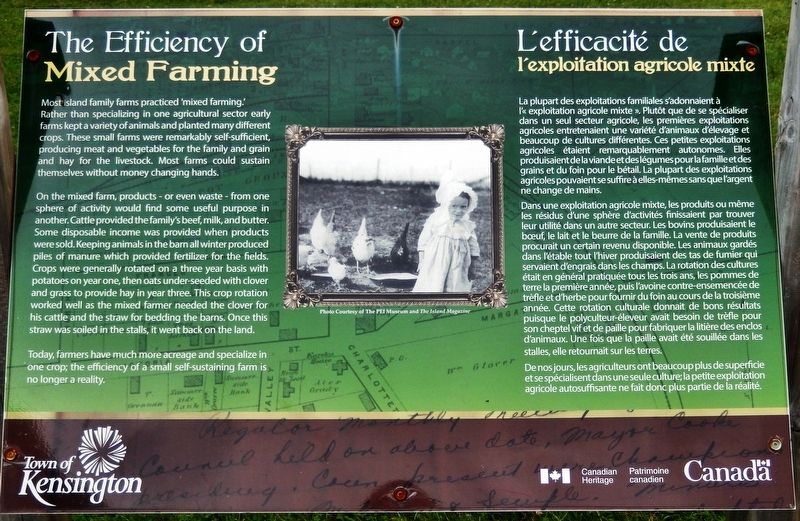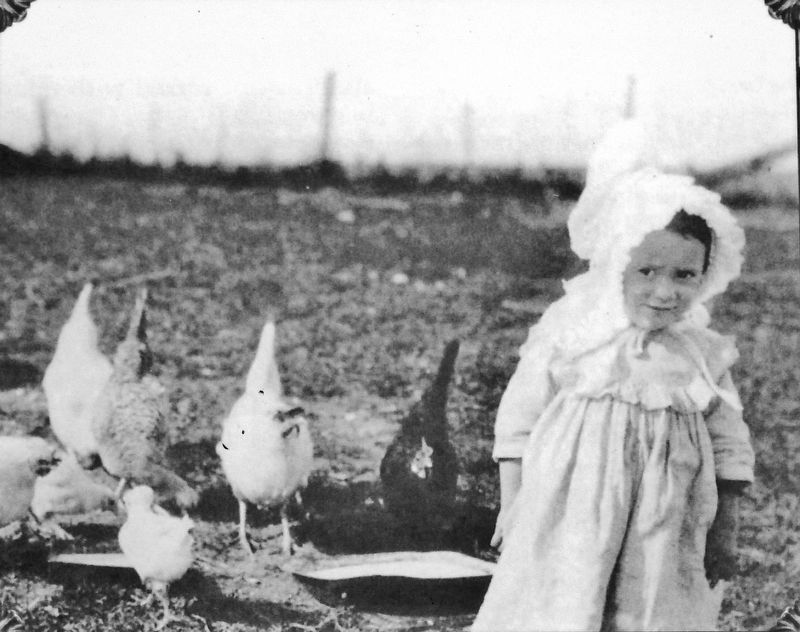Kensington in Prince County, Prince Edward Island — The Atlantic Provinces (North America)
The Efficiency of Mixed Farming
L’efficacité de l’agriculture mixte
Most Island family farms practiced “mixed farming.” Rather than specializing in one agricultural sector early farms kept a variety of animals and planted many different crops. These small farms were remarkably self-sufficient, producing meat and vegetables for the family and grain and hay for the livestock. Most farms could sustain themselves without money changing hands.
On the mixed farm, products — or even waste — from one sphere of activity would find some useful purpose in another. Cattle provided the family's beef, milk, and butter. Some disposable income was provided when products were sold. Keeping animals in the barn all winter produced piles of manure which provided fertilizer for the fields. Crops were generally rotated on a three year basis with potatoes on year one, then oats under-seeded with clover and grass to provide hay in year three. This crop rotation worked well as the mixed farmer needed the clover for his cattle and the straw for bedding the barns. Once this straw was soiled in the stalls, it went back on the land.
Today, farmers have much more acreage and specialize in one crop; the efficiency of a small self-sustaining farm is no longer a reality.
La plupart des exploitations familiales s'adonnaient à l'« exploitation agricole mixte ». Plutôt que de se spécialiser dans un seul secteur agricole, les premières exploitations agricoles entretenaient une variété d'animaux d'élevage et beaucoup de cultures différentes. Ces petites exploitations agricoles étaient remarquablement autonomes. Elles produisaient de la viande et des légumes pour la famille et des grains et du foin pour le bétail. La plupart des exploitations agricoles pouvaient se suffire à elles-mêmes sans que l'argent ne change de mains.
Dans une exploitation agricole mixte, les produits ou même les résidus d'une sphère d'activités finissaient par trouver leur utilité dans un autre secteur. Les bovins produisaient le bœuf, le lait et le beurre de la famille. La vente de produits procurait un certain revenu disponible. Les animaux gardés dans l'étable tout l'hiver produisaient des tas de fumier qui servaient d'engrais dans les champs. La rotation des cultures était en général pratiquée tous les trois ans, les pommes de terre la première année, puis l'avoine contre-ensemencée de trèfle et d'herbe pour fournir du foin au cours de la troisième année. Cette rotation culturale donnait de bons résultats puisque le polyculteur-éleveur avait besoin de trèfle pour son cheptel vif et de paille pour fabriquer la litière des enclos d'animaux. Une fois que la paille avait été souillée dans les stalles, elle retournait sur les terres.
De nos jours, les agriculteurs ont beaucoup plus de superficie et se spécialisent dans une seule culture; la petite exploitation agricole autosuffisante ne fait donc plus partie de la réalité.
Erected by Town of Kensington, and Department of Canadian Heritage.
Topics. This historical marker is listed in this topic list: Agriculture.
Location. 46° 26.157′ N, 63° 38.495′ W. Marker is in Kensington, Prince Edward Island, in Prince County. Marker can be reached from Imperial Street just north of Commercial Street, on the left when traveling north. Marker is located along the Confederation Trail, about 1 block west of the former Kensington Railroad Depot. Touch for map. Marker is at or near this postal address: 29 Commercial Street, Kensington PE C0B 1M0, Canada. Touch for directions.
Other nearby markers. At least 8 other markers are within walking distance of this marker. Potato Farming Between the Tree Stumps (a few steps from this marker); A Woman's Work is Never Done (within shouting distance of this marker); Original Meaning of Horsepower (within shouting distance of this marker); The Seven Year Rotation (within shouting distance
of this marker); A World Leader in Silver Foxes (within shouting distance of this marker); The Early Days of Farm Equipment (about 90 meters away, measured in a direct line); Farming Groups in Kensington (about 90 meters away); Business and Agriculture (about 120 meters away). Touch for a list and map of all markers in Kensington.
Related markers. Click here for a list of markers that are related to this marker. Prince Edward Island Agriculture
Credits. This page was last revised on May 18, 2020. It was originally submitted on May 14, 2020, by Cosmos Mariner of Cape Canaveral, Florida. This page has been viewed 104 times since then and 7 times this year. Photos: 1. submitted on May 17, 2020, by Cosmos Mariner of Cape Canaveral, Florida. 2, 3. submitted on May 18, 2020, by Cosmos Mariner of Cape Canaveral, Florida.


